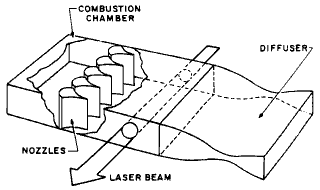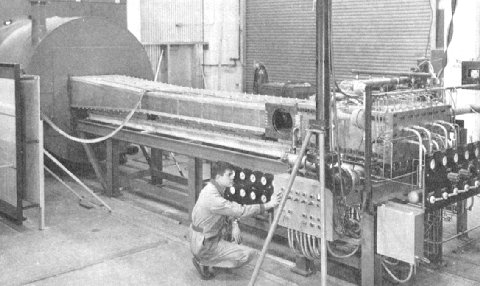GAS DYNAMIC LASER
In 1962 Basov and Oraevskii proposed that rapid cooling could produce
population inversions in molecular systems. A few years later others
suggested that this could be accomplished by expansion of a hot gas through
a supersonic nozzle. And in 1966, the first gasdymamic laser was successfully
operated at the Avco Everett Research Lab. (Gerry, 1970).
According to Anderson (1976) gas dynamic lasers are first cousins to rocket
engines. They also share design similarities with
supersonic wind tunnels.
In rocket nozzles, aerodynamicists work hard to create equilibrium flows so as
to obtain maximum specific impulse; on the other hand in a laser, all possible
efforts are made to produce a highly non-equilibrium expansion.

Adiabatic Expansion Cooling Gasdynamic Laser : Hot gases expand through
appropriately shaped nozzles from a high pressure, high temperature chamber
into a low pressure chamber. This creates a highly non-equilibrium region were
a strong population inversion takes place. Very high laser output power can be
achieved. The diffuser is used to shock down the supersonic flow to subsonic
speeds, then the gases are generally exhausted to the atmosphere.
Population inversions require that the lasing medium be forced as far as
possible from equilibrium. In equilibrium, statistical thermodynamics tells us
that the upper levels have an exponentially decreasing population as a
function of increasing energy, which means that the lower quantum levels have a
larger population than the upper levels, thus a photon is more likely to cause
an absorption. In highly non-equilibrium situations, the populations are
reversed and the upper level is overpopulated relative to the lower level,
and a photon is more likely to induce a stimulated emission, hence laser
action is possible.
 |
| Large scale 135 Kilowatt gasdynamic laser at Avco Everett Research Lab, Inc.
was among the first very high power lasers.
Initially this research was classified by the U.S. government,
even today information on these types of lasers is scarce.
(Gerry, 1970) |
Non-equilibrium turbulent flows are much more likely to occur in rapidly
expanding stellar atmospheres where ideal equilibrium flows are rarely
encountered. If adiabatic expansion alone can produce one of the most powerful
lasers on earth; this mechanism should also be one of the most prevalent
astrophysical means of producing laser action.
PRACTICAL USE
High power CO2 lasers are used in manufacturing for drilling, cutting,
welding, heat-treating and alloying (LaRocca, 1982). Some of these
lasers are so powerful that beams emerging from the chamber could
potentially destroy the optics. For a time the gasdynamic laser was
seriously considered for use in the space based
Strategic Defence Initiative (SDI) or Star Wars program.
REFERENCES
- Anderson,J.D.: 1976, Gasdynamic Lasers: An Introduction, Academic Press,
New York.
- 1996 papers and
1997 papers
- Takaishi,T., Mizuno,M., Watanuki,T., Kubota,H. et al. : 1995,
Proc. 39th Space Sci. Tech. Conf., Osaka, 1995, 627 (Japanese)
Study of the Multiple Nozzles of a Combustion Driven CO2 Gasdynamic Laser
- Takaishi, T., Watanuki, T., Kubota, H. et al. : 1995,
AIAA Paper 95-1996, 26th AIAA Plasmadyn. and Lasers Conf., San Diego
Numerical Simulation of Power Extarction of CO2 Gasdynamic Laser
- Takaishi, T., Sugitaya, T., Watanuki,T., Kubota, H. et al. : 1995,
AIAA Paper 95-1997, 26th AIAA Plasmadyn. and Lasers Conf., San Diego (Japanese)
The Effect of Nozzle Shapes on the Performance of the Combustion Driven CO2 Gasdynamic Laser
- Watanuki, T., Mizuno, M., Takaishi, T., Kubota, H. et al. : 1996,
Proc. 45th Nat. Cong. of Theor. and Appl. Mech., Tokyo, 1996, 301 (Japanese)
Characteristics of Combustion Driven CO2 Gasdynamic Laser
- Shinjo,J., Mizuno, M., Watanuki,T., Kubota, H. et al : 1996
Proc. 27th JSASS Annu. Meet., 72 (Japanese).
Experimental Study on the Performance of Multiple Nozzles for CO2 Gasdynamic laser
- Mizuno, M., Shinjo, J., Watanuki, T., Kubota, H. et al : 1996
20th Int. Symp. on Space Tech. Sci., Gifu, 1996, Paper ISTS 96-d-28.
Numerical Simulation of Laser Propagation with Multiple Nozzles of CO2 Gasdynamic Laser
- Shinjo, J. : 1996,
20th Int. Symp. on Space Tech. Sci., Gifu, 1996, Paper ISTS 96-n-02.
Performance of Multiple Nozzles of Gasdynamic Laser for Re-entry Simulation
- Mizuno, M., Shinjo, J., Watanuki, T., Kubota, H. : 1996
Proc. 28th Fluid Dyn. Conf., Toyama, 1996, 79 (Japanese).
Flow Visualization for supersonic Flow Field in a Resonator of Combustion Driven CO2 Gasdynamic Laser
- Mizuno, M., Shinjo, J., Watanuki, T., Kubota, H. : 1996
Proc. 40th Space Sci. Tech. Conf., Morioka, 249 (Japanese).
Effects of Supersonic Diffuser Design on Working Characteristics of Combustion Driven CO2 Gasdynamic Laser
- Shinjo, J., Mizuno, M., Watanuki, T., Kubota, H. et al : 1996
Proc. 27th JSASS Annu. Meet., 72 (Japanese).
Experimental Study on the Performance of Multiple Nozzles for CO2 Gasdynamic laser
- RFNC-VNIIEF research on gas dynamic CO2 lasers
- Convective & Wave Processes Laboratory, Belarus National Academy of Sciences
- Soloukhin, R.I., Fomin, N.A. : 1984, Mixing Gasdynamic Lasers, Minsk, Nauka i Technika Press.
- Novikov, S.S., Koudriavtsev, N.N. : 1985, Diagnostics of Non-Equilibrium Molecular Distributions in Laser Systems.
- Soloukhin, R.I., Fomin, N.A., N.N.Kudriavtsev,N.N., Novikov, S.S.: 1987, Diagnostics of Molecular Levels in a Nonequilibrium Flows,
- Fomin, N.A.: 1989, Speckle Interferometry of a Gasdynamic Flows. Nauka i Technika Publ. House, Minsk
- Achasov,O.V.: Heat and Mass Transfer Institute, Belarus Academy of Sciences
- Dr. N. K. Mitra, AOR Institut für Thermo- und Fluiddynamik Ruhr-Universität Bochum
- Mitra, N.K., Fiebig,M.: 1974,
Proc. 9th International Symposium on Rarefied Gas Dynamics, S. B 21 p.1, Göttingen.
Low Reynolds Number Vibrational Nonequilibrium Flow in Laval Nozzle
- Mitra, N.K., Fiebig,M.: 1975,
Proc. 1. GAMM Conference on Numerical Methods in Fluid Mechanics, Okt., Köln, p.98.
Flowfield Computation through Sonic Saddle Point in Viscous Frozen and Nonequilibrium Nozzle Flows
- Mitra, N.K., Fiebig,M.: 1975,
Nozzle Flows, ZfW, Feb., p.39.
Low Reynolds Number Hypersonic
- Mitra, N.K., Fiebig,M.: 1975,
DLR-FB 75-64, DFVLR, Köln.
Comparision of Slender Channel Computations with Experiments for Low Reynolds Number Hypersonic Nozzle Flows
- Mitra, N.K., Fiebig,M.: 1976,
AIAA Journal, März. p.406.
Determination of Stagnation Chamber Temperature in High Enthalpy Nozzle Flows
- Mitra, N.K., Fiebig,M.: 1976,
Nichtgleichgewichtsprobleme in der Strömungsmechanik, herausgegeben von K. Robert, DFVLR, Press Köln,, p.211
Nozzle Flows with Vibrational Dissociational Nonequilibrium
- Mitra, N.K., Fiebig,M.: 1976,
Proc. Gasdynamic and Chemical Laser, 1. International Symposium, Okt., Köln, S. 298-340, DFVLR Press
Viscous Nozzle Flows and CO2 Gasdynamic Laser
- Mitra, N.K., Fiebig,M.: 1977,
ZAMM 57, p.293.
Effects of Wall Temperature on CO2 Gasdynamic Laser Performance
- Mitra, N.K., Fiebig,M.: 1977,
Progress in Astronautics and Aeronautics, v. 51, Part , AIAA, p.885.
Effects of Vibrational Wall Accommodation on Small Signal Gain in CO2-N2-H2O Gasdynamic Laser (GDL),
- Mitra, N.K., Fiebig,M.: 1977,
DLR FB 77-36, p.133.
Similarity in Nozzle Flows with Vibrational Nonequilibrium
- Mitra, N.K., Fiebig,M.: 1978,
ZAMM 58, T 269.
Similarity Considerations for Nonequilibrium Nozzle Flows
- Mitra, N.K., Fiebig,M.: 1978,
Proc. Eleventh International Symposium on Rarefied Gasdynamics, Cannes, p.857.
Low Reynolds Number Nozzle Flows with Vibrational Dissociational Nonequilibrium,
- Mitra, N.K., Fiebig,M.: 1978,
Proc. 2nd International Symposium on GCL, J. Wendt (ed), von Karman Institute, Brussels.
Small Signal Measurements in High Area CO2 GDL Nozzle,
- Mitra, N.K., Fiebig,M.: 1979,
Recent Developments in Theoretical and Experimental Fluid Mechanics, p.157, Springer Verlag,
Supersonic Nozzle Flowfields: A Comparision on Fully Viscous and Navier-Stokes Solution
- Mitra, N.K., Fiebig,M.: 1979,
Forschungsberichte 2845 des Landes NRW, Westdeutscher Verlag.
Untersuchungen zum Gasdynamic-Laser
- Basov,N.G., Oraevskii,A.N.: 1963, Sov.Phys.JETP., 17, 1171.
- Gerry,E.T.: 1970, IEEE Spectrum, 7, 51.
- LaRocca,A.V.: 1982, Scientific American, (March) page. 94,
'Laser Applications in Manufacturing',
-
Industrial Laser Review (from
PennWell Publishing Co.)
-
WWW : NASA Technical Reports on aerodynamic research (NTRS)
-
Minucci,M.A.S., Oliva.J.L.S.: 1993, AIAA PAPER 93-3187, 24 th Plasmadynamics and Lasers Conference
On the development of a gas generator for CO2-N2 gas dynamic lasers utilizing liquid fuel and liquid oxidizer
-
Biriukov,A.S., Konoplev,N.A., Shcheglov,V.: 1981, Pis'ma v Zhurnal Tekhnicheskoi Fiziki, 7, 482.
Energy capabilities of a three-frequency periodic-pulse CO2 gas-dynamic laser
-
Krause,S., Maisenhaelder,F.: 1980, Applied Optics, 22, 421.
Gasdynamic CO laser with closed-cycle gas flow
-
Huegel,H., Schall,W., Hoffmann,P.: 1976, DFVLR-Nachrichten, (Nov), 784.
Gas dynamic CO2 laser output increase with the aid of appropriate supersonic mixing techniques
-
Murthy,S.N.B.: 1976, in High-power gas lasers, Summer School (IOP), Capri,, Italy,
September 1975, p.222
Gas-dynamic and chemical lasers - Gas dynamics
-
Fournier,G., Morency,J.P.: 1975, NASA DREV-4011/75
Preliminary analysis of a light-gas gun-driven gas dynamic laser
-
Cavalleri,R.J.: 1975, in Hydrogen energy, Proc., Miami Beach,, Fla., Plenum Press, p. 677
A hydrogen-fueled gas-dynamic laser
-
Shmelev,V.M., Vasilik,N.IA., Margolin,A.D.: 1974, Kvantovaia Elektronika (Moscow), 1, 1711.
Gas dynamic CO2+N2+CO+H2O laser
-
Genaralov,N.A., Kozlov,G.I., Selezneva,I.K.: 1974, NASA AD-783445, Air Force Systems Command, Wright-Patterson AFB, OH.
Estimate of the characteristics of a gas-dynamic laser
-
Biryukov,A.S., Marchenko,V.M., Shelepin,L.A.: 1974, NASA JPRS-63317, Joint Publications Research Service, Arlington, VA.
Gas dynamic laser with electric excitation of a thermally ionized gas
-
Pallay,B.G., Zovko,C.T.: 1973, AIAA PAPER 73-1233
Fuels, oxidizers and gas generators for gas dynamic lasers
-
Yatsiv,S., Greenfield,E., Dothan-Deutsch,F., Chuchem,D.: 1972,
in Laser Engineering and Applications
IEEE Journal of Quantum Electronics, vol. QE-8, Feb. 1972, pt.,2, page 161.
Experiments with a pulsed CO2 gas dynamic laser. (combustion driven)
-
McMahan,W.H.: 1971, Optical Spectra, 5, 30.
High-power, visible-output, gas-dynamic lasers.
Supersonic Wind Tunnels
Laser History


